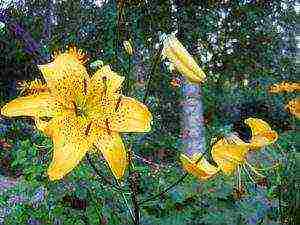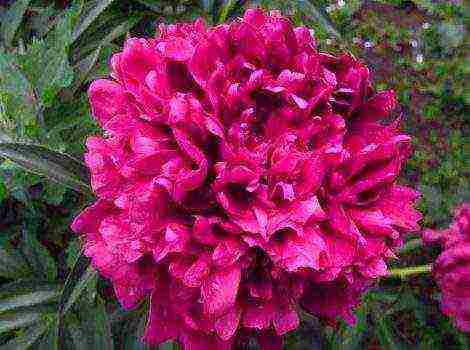Content
- 1 Description
- 2 Lavender for cold regions
- 3 Features and preferences
- 4 Seat selection
- 5 Soil
- 6 Lavender, planting and care in the Leningrad region. Photo of the correct placement of seedlings
- 7 Care
- 8 Pruning
- 9 Preparing for winter
- 10 Indoor lavender
- 11 Seed propagation
- 12 Vegetative reproduction
- 13 Lavender varieties
A simple, but at the same time, a pretty fragrant blue flower, some associated with French Provence, others reminiscent of the nostalgic song of Sofia Rotaru, and the third - a remedy for moths - all this is a modest beauty lavender. Planting and care in the Leningrad region is possible, only you need to take into account some of its features, choose the right varieties and provide it with acceptable wintering conditions. Many gardeners living in the northern regions of Russia have been growing lavender for a long time and with good results on their plots in the open field. We invite you to get acquainted with their secrets.
Description
Although there are not so many of them, there are people who find it difficult to say what lavender looks like. In the Leningrad region and in any other region of the world, its appearance is practically the same. In total, about 50 species and hybrids of this flower are currently known, differing from each other in the structure of the flowers, the tone of the petals, and the shape of the leaves. All of them are herbaceous perennials, growing lush bushes with an average height of about 1 meter. The lower shoots become lignified over time. The root of all lavenders is pivotal, hard, also almost woody, forming multiple branches in the upper part. The leaves in the vast majority of species are covered with delicate hairs, giving them a grayish tint. Flowers are collected in spikelet inflorescences.
Lavender for cold regions
Among others, real or narrow-leaved lavender is grown most successfully in the Leningrad region. The description of this species is not much different from the general description of the plant. The height of narrow-leaved lavender bushes can be from 30 cm to 1 meter. In shape, its leaves, as the name suggests, are narrow, elongated, opposite, without petioles (sessile), up to 6 cm long. Their color seems silvery-green due to the hairs. The shoots of this lavender are tetrahedral. The flowers are arranged in whorls in the spikelets. The corolla of the flowers are two-lipped, up to 1 cm long. The color of the petals is from deep blue to violet. But there are varieties with white, purple and pink petals. Lavender bloom begins in early June and, with proper care, lasts until mid-autumn. At the end, small cups remain on the stems, in which four nut seeds ripen.
Features and preferences
Even the ancient Greeks were well known as a medicine and a wonderful honey plant lavender. Planting and caring for this flower in the Leningrad region can cause difficulties, since by its nature it is a "southerner". Lavender is considered the birthplace of the Mediterranean, and in nature it grows in the south of France, Spain, North Africa, the Canary Islands, Australia, India, and the Caucasus. Lavender loves sun and warmth rather than strong winds and lots of water. Sometimes you can find information that it calmly tolerates frosts down to -25 ° C, but this is more an exception than a regularity.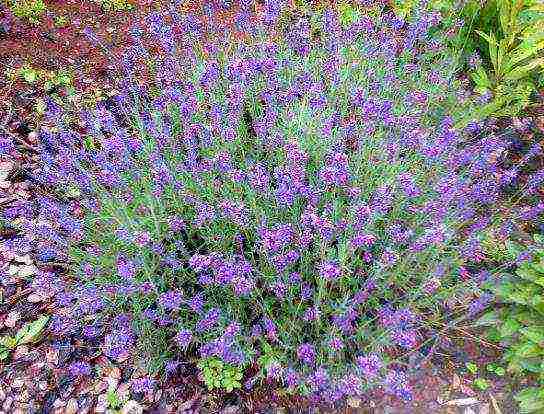 If we recall the climatic conditions of the north-west of Russia, the question arises: "Will lavender grow in the Leningrad region?" The photo demonstrates what wonderful lavender bushes are obtained by some gardeners. And this is despite the fact that it is not hot here in summer, windy and quite cool in winter, and groundwater is often too close to the surface, which is why there are many wetlands in this region.Plus to all these unsuitable conditions in the Leningrad region there is a large percentage of podzolic soils and loams, and lavender needs light and alkaline ones. What do gardeners advise so that lavender still takes root?
If we recall the climatic conditions of the north-west of Russia, the question arises: "Will lavender grow in the Leningrad region?" The photo demonstrates what wonderful lavender bushes are obtained by some gardeners. And this is despite the fact that it is not hot here in summer, windy and quite cool in winter, and groundwater is often too close to the surface, which is why there are many wetlands in this region.Plus to all these unsuitable conditions in the Leningrad region there is a large percentage of podzolic soils and loams, and lavender needs light and alkaline ones. What do gardeners advise so that lavender still takes root?
Seat selection
Nowadays, agricultural technology is so well developed that even in the wrong conditions, lavender can bloom luxuriantly. Planting and care in the Leningrad region will give a good result if the right place is initially chosen for this flower. In this case, it is imperative to observe the low humidity and sufficient lighting required for the plant. 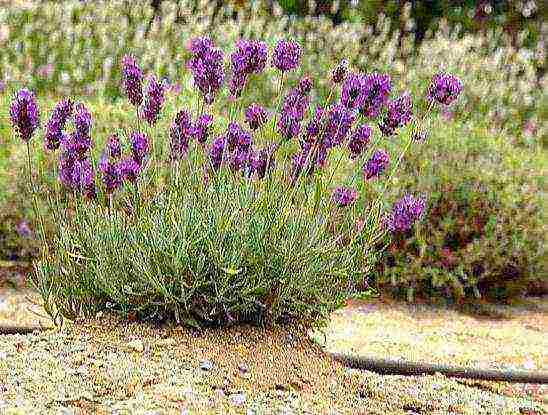 That is, lavender will have to be planted in a sunny meadow, where there is no groundwater close to the surface of the earth and puddles never form after rain. In partial shade, only broad-leaved lavender can take root, but it does not like cold weather at all, so it is almost never grown in the Leningrad region. If the site is located in a swampy and constantly damp area, but you really want to plant lavender, you will have to, firstly, arrange powerful drainage for it, and secondly, build an embankment over it from suitable soil.
That is, lavender will have to be planted in a sunny meadow, where there is no groundwater close to the surface of the earth and puddles never form after rain. In partial shade, only broad-leaved lavender can take root, but it does not like cold weather at all, so it is almost never grown in the Leningrad region. If the site is located in a swampy and constantly damp area, but you really want to plant lavender, you will have to, firstly, arrange powerful drainage for it, and secondly, build an embankment over it from suitable soil.
Soil
For lavender to take root in the Leningrad region, cultivation must begin with the correct planting. We have already chosen a place for her. Now you need to provide her with a suitable soil. Lavender is not particularly demanding on its fertility. In nature, it often grows on rocky slopes or wastelands, where there are very few useful trace elements for other plants. This does not interfere with lavender, but the increased acidity is destructive for it. So that, planted in the garden, it does not hurt, it is advisable to check the soil for pH. If the indicator is below 7, it will need to be lime. In addition, lavender roots must breathe, which means that heavy soils are not suitable for it either. Sand or any other baking powder helps to deal with this problem. Experienced gardeners advise adding ash to the soil.
Lavender, planting and care in the Leningrad region. Photo of the correct placement of seedlings
A beautiful shy lavender does not like transplants, so it should be planted right away where it will grow all its life. The drainage and embankment was built for it, the soil was prepared. Now you need to make holes for each plant about 30-35 cm deep. The distance between them, if you plan to have lush bushes, should be equal to the height of an adult plant. If it is planned to create a thick carpet or a living border from lavender, the distance between the holes is halved. Before placing in the ground, gardeners recommend keeping the seedlings in water for about an hour. Next, you need to remove the lower shoots and the top from them. Having planted the young lavender in the hole, its roots are carefully sprinkled with earth, tamped so that the air that is not needed so far is watered.
Care
Already in many gardens, lavender grows in the Leningrad region. Planting and caring for her, although they require compliance with the rules, are quite simple. The main thing to remember is that lavender does not like high humidity. Therefore, you need to water the plant very carefully and only when the soil under its bushes is dry. With an excess of water, lavender roots rot, and with drought, it blooms poorly. Therefore, in the case of lavender, it is better to underfill than overflow.
The second indispensable condition for successful lavender cultivation is weeding and loosening the soil under the bushes so that the roots can breathe freely. Gardeners recommend mulching the soil, then the moisture remains constant for a long time, and there is no need to loosen it. And if you take compost as mulch, then you don't need to fertilize lavender. In general, this plant responds well to infrequent feeding with mineral mixtures. This is done during the blooming period. And in the spring, it is recommended to pamper lavender with nitrogen-containing complexes so that the bushes are especially lush.
Lavender has practically no pests, so there is no need to treat it with chemicals.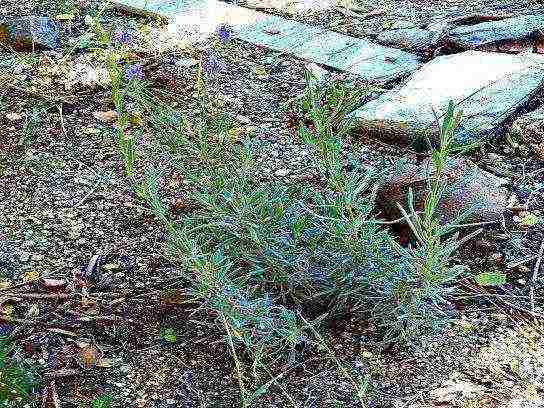
Pruning
In order for lavender to grow beautifully, planting and care in the Leningrad region includes a pruning process.In principle, you can do without it, but those who want the lavender to bloom longer and more magnificently, be sure to cut off the shoots with faded inflorescences.
Pruning is also required to rejuvenate aged lavender bushes. In this case, the shoots are cut almost at ground level, after which the plant is watered.
Pruning is also needed to grow lavender as a medicinal plant. All its aboveground parts, especially flowers, contain lavender oil, geraniol, tannins, cineole, bitterness, coumarin. To catch the maximum amount of these chemical elements in flowers, they must be cut off immediately after blooming.
Another reason for pruning is to provide air for the remaining shoots. That is, this work is performed to thin out heavily thickened bushes.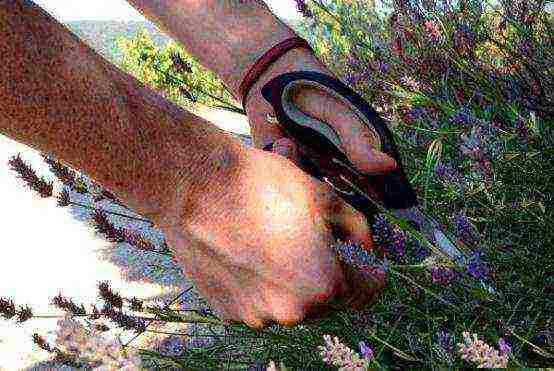
Preparing for winter
In order for lavender bushes to survive the cold, it is recommended to shorten them before frost. Shoots are pruned with a gentle method, leaving stems up to 10 cm long above the ground. Some gardeners recommend not cutting lavender at all in the Leningrad Region in the fall. The opinions of experts differ regarding her winter shelter. Some recommend that you wrap up the bushes with covering material, plywood boxes or spruce branches. Others advise not to cover at all, as some varieties can withstand temperatures around -20 ° C, for example, narrow-leaved lavender. In the Leningrad Region, planting and caring for this variety has already been mastered quite well. And it overwinters relatively normally, but there are reports from gardeners that even in the Krasnodar Territory, where it is much warmer, uncovered lavender froze over the winter.
Indoor lavender
Some gardeners, so as not to take risks, lavender, especially French, which is a big sissy, is grown in pots. In the winter she lives in the house, and in the summer she goes to the garden. With this method of cultivation, it must be remembered that lavender loves warmth and sun only if it grows in the open field, and in a pot its roots can burn out from the heat. Therefore, pots with a plant in the summer in the garden should be buried, and in the fall, before entering the room, they should be dug out. At home, potted lavender must also be protected from overheating, kept in bright but cool rooms in winter, and removed from window sills in summer, where direct rays of the sun shine for long hours. Watering and loosening the soil in pots is done in the same way as in the open field. Important: containers for potted lavender need to be selected spacious so that the roots have room to grow.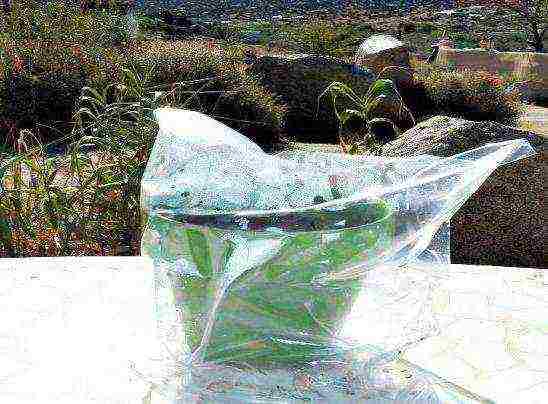
Seed propagation
Lavender multiplies quite successfully, and in different ways, in the Leningrad region. How to grow it from seeds? This process is not so much difficult as troublesome.
It is often recommended to stratify lavender seeds by keeping them in the refrigerator all winter, and sow them either directly in the beds or in boxes in the spring. But, as experience has shown, lavender seeds need not be frozen, but heated, which increases the germination rate up to 90%. To do this, they just need to be placed in very warm water (t = 40-45 ° C), then rinse thoroughly, dry a little and sow in prepared containers. The fact is that almost hot water dissolves the oils and fats that cover the seeds, which helps them germinate more actively. The substrate in containers should consist of garden soil with sand, vermiculite can be added. Having placed the seeds in the soil, they need to be covered with a bag or glass, sprinkled with water (the soil should be slightly damp all the time of germination) and put where it is warm, but not hot and there is no bright sunlight. As soon as shoots become noticeable, the glass is removed. The sprouts are watered very sparingly, and planted in the ground when the ground is free of snow and warms up enough. The first year, the bushes of young lavender will not be fluffy, and they will delight with flowers only next summer.
Vegetative reproduction
Lavender is most successfully propagated by cuttings and layering in the Leningrad region.The features of growing by cuttings are as follows. Cuttings are harvested from annual shoots, cutting them into pieces 10-12 cm long. Then they are placed in the prepared soil, watered a little, covered with a film (they make a greenhouse). Such a cutting takes roots very quickly.
It is also easy to propagate lavender by layering. You just need to bend the selected shoot to the ground, fix it in this position and dig it in so that the top remains outside. Drizzle. After about one and a half to two months, the already rooted twig must be cut off from the mother plant and planted in a chosen place.
If there is a heavily overgrown lavender bush on the site, it can be divided into two or more fragments that will give new plants. To do this, in the summer, shoots are cut off from such a bush, they are well spud, and in the fall they carefully dig out and divide the bush into parts, which are immediately planted.
 Lavender is a valuable plant with a delicious aroma and rich lilac flowers that has a number of beneficial properties. In the wild, it grows in North and East Africa, Arabia, Australia, India, the Canary Islands and southern Europe. As a habitat, lavender chooses rocks and mountain slopes, where the land is rocky and poor. French Provence is famous for its vast lavender fields. The plant belongs to the Lamb family. The ancient Greeks and Romans used the plant during washing and washing. Hence it got its name, which comes from the Latin "lava" and means the word "wash".
Lavender is a valuable plant with a delicious aroma and rich lilac flowers that has a number of beneficial properties. In the wild, it grows in North and East Africa, Arabia, Australia, India, the Canary Islands and southern Europe. As a habitat, lavender chooses rocks and mountain slopes, where the land is rocky and poor. French Provence is famous for its vast lavender fields. The plant belongs to the Lamb family. The ancient Greeks and Romans used the plant during washing and washing. Hence it got its name, which comes from the Latin "lava" and means the word "wash".
Description of the plant and useful properties
Lavender is a perennial plant.... The evergreen shrub has a fibrous root system that goes two hundred centimeters deep into the ground. The lignified stems at the bottom can grow up to sixty centimeters in height. Some varieties are up to a meter.
The straight leaves of a rich green color with a silvery sheen are opposite and slightly pubescent. In some varieties, the leaves are narrow and thin, while in others they are wide and rounded.
Small flowers form spike-shaped inflorescences, arranged in whorls of six to ten pieces. Inflorescences appear at the top of the shoots that do not have leaves. The classic color of lavender flowers is lilac with a blue tint, but there are flowers in other shades: snow-white, bluish, lilac and pink. The flowers give off a delicious spicy scent that spreads throughout the area. Due to this aroma, the plant is an excellent honey plant. Depending on the climate lavender bloom can be seen from June to August. Lavender seeds retain their germination ability for a long time if they are stored properly.
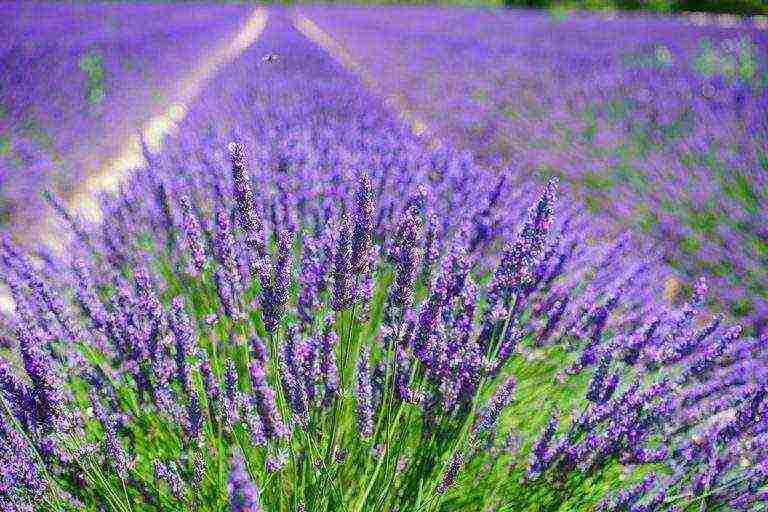
Lavender is especially prized for its precious essential oil. It is obtained most often from lavender broadleaf. Medicinal lavender is cultivated for medicinal purposes. The healing properties of the plant were known even during the existence of Ancient Greece. Lavender has been used to treat a wide variety of diseases.
Lavender contains essential oil, coumarins, flavonoids, tannins, resins, terpene alcohols, bitterness and other substances. Lavender soothes, relieves pain, disinfects, promotes tissue repair, expels worms, and also has a diuretic, antispasmodic and bactericidal effect. Lavender tidies up the nervous system, has a beneficial effect on sleep and improves mood. It is used for diseases of the bladder, disorders of the gastrointestinal tract, respiratory system and musculoskeletal system.

Characteristics of lavender varieties
Toothed lavender is a compact plant with large flowers. This variety can be successfully grown at home.This species is most often sold in gardening stores. He does not tolerate frost, but hibernates in a cool room with enough light.
- French lavender (broadleaf) is a plant with broad leaves and rich color. The buds are colored less brightly than other varieties, and the smell is sharper and more noticeable.
- Narrow-leaved lavender (English) is a shrub with narrow leaves. It reaches a meter in diameter. This variety perfectly tolerates the winter months, it is easy to care for it. Narrow-leaved lavender blooms in the middle of summer. Variety "Hidkot" is characterized by deep purple flowers and small silvery leaves. Fragrant Provence flowers are used in the production of oils and for culinary purposes. The variety called "Manstad" is distinguished by its blue flowers and high decorative qualities.
- Hybrid lavender is the result of a combination of narrow-leaved and broad-leaved varieties. It is quite common among gardeners.
- Stekhad lavender dissolves pink-purple flowers and blooms from March to June. The leaves reach a length of one to four centimeters and are grayish in color.
- Lavender woolly differs in tubular flowers of purple color, forming spike-shaped inflorescences. This variety is difficult to tolerate rainfall and excessive soil moisture, so it is well suited for growing indoors.
How to grow lavender from seeds (video)
Propagation of lavender in the garden by seeds, seedlings and cuttings
Before planting, lavender seeds must be stratified, which is carried out in February. Seeds are sown in a container filled with wet sand or peat, then covered with a film. For thirty to forty days, a bowl with seeds is left in a room with a temperature of plus three to minus five degrees. For these purposes, a basement, cellar or refrigerator with a specified temperature is suitable. The dish is regularly ventilated and disposed of condensation. After the specified period, the bowl is placed in a warm place with a temperature of fifteen to twenty degrees so that the seeds begin to germinate. A well-lit window sill is ideal for placement. Seedlings will not stretch if there is enough light.
When the planting material has four to six leaves, the seedlings are seated in separate pots - they dive. Pinch the top of each plant, counting five to six pairs of leaves, so that it bushes well. Seedlings are planted in the garden in Maywhen the frost is gone. Saturated lilac flowers will appear next year.
If it is not possible to grow seedlings, the seeds can be sown directly into the open ground. This is done in October. The seeds are sown to a depth of four millimeters and covered with sand on top. Then the soil is moistened, and in winter more snow is thrown on the place where the seeds are planted.
Lavender can be grown from cuttings, which is easier than seed propagation. In late June - early July, cuttings are cutusing the middle of the one year old shoots, which are only half lignified. Each stalk should be ten centimeters long. The leaves on the bottom are removed. For cuttings, a greenhouse is prepared with a soil consisting of peat and sand in a one-to-one ratio. The tips of the cuttings are treated with a rapid root formation agent and planted. After a month, young plants will have roots. Lavender, propagated in this way, is planted in open ground until mid-August.
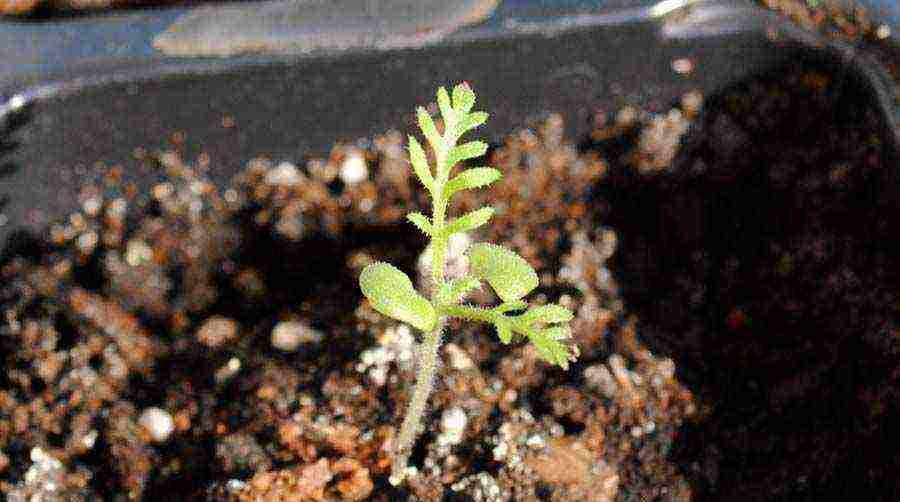
Features of transplanting a plant in the fall to a new place
Lavender is difficult to tolerate a transplant, but in some cases this procedure is necessary. The plant is transplanted if the bush has stopped growing, the plant needs to be transplanted to a more suitable place, or a large bush needs to be divided.The plant has a very strong root system, which can go three to four meters into the depths of the soil.
The shrub is dug out carefully, damaging the roots as little as possible. The preferred time for replanting lavender is autumn. Lavender needs at least two months to take root before frosts come. If it is necessary to divide a large bush, the root system is divided into several parts using a garden knife. Each part must remain rooted. Places of cuts are sprinkled with coal and each new plant is planted in a permanent place.
Planting lavender outdoors
Lavender seedlings are planted in open ground at the end of May. The plant is used to decorate alpine hills, flower beds. Lavender is planted near curbs and paths.

Soil selection
A suitable place for planting lavender is immediately chosen carefully, because the transplantation negatively affects the plant. Lavender can live comfortably in one place for twenty years. A sunny area located in the south or southwest of the garden is suitable for her. If the shade falls on the lavender, it will not bloom lush. In areas located in the lowlands and periodically flooded, flowers are not planted. If there is no suitable place for a plant in the garden, then artificially create beds forty centimeters high, be sure to organize drainage from expanded clay or crushed stone.
Lavender loves slightly alkaline or neutral, sandy or slightly rocky soils, in which moisture does not retain. Sand, lime and compost are added to clay soils, which are quite heavy. If the groundwater reaches a high level, drainage must be organized.
Breeding methods for lavender (video)
Planting process
Before planting, the soil is prepared by digging to a depth of twenty centimeters, and loosened by adding compost or peat.
Seedlings are planted in the garden, keeping a distance of eighty to ninety centimeters. If tall lavender is planted, the distance is increased to one hundred and twenty centimeters. The hole should accommodate the root system of the seedling and not constrain it. Before planting, the roots are shortened a little.... The bush is placed in a hole and covered with earth. The root collar is buried to a depth of four to six centimeters. The planted plants are well watered.
In places where a warm climate prevails in winter, the seeds of the plant are sown directly into the open ground. The process takes place in October. First, the soil is prepared, fine gravel or sand is introduced into the wet ground in order to increase the air and moisture permeability of the soil. Seeds are sown to a depth of three to four centimeters, then the soil is compacted and the crops are watered, if the autumn months are not generous with rains.
Secrets of proper care for lavender
Water the flower as the soil dries out, because excessive moisture saturation can cause rotting of the root system. It is also not recommended to allow the plants to dry out. During irrigation, a stream of water is directed under the root system, trying not to fall on the leaves. In the spring and autumn months, the bushes spud... The plant needs a haircut.
In the spring, the plant is fertilized using nitrogen fertilization. For ten liters of water add a tablespoon of urea or two tablespoons of "sodium humate". The resulting fertilizer is watered with lavender bushes, spending five to six liters per plant.
When lavender begins to bloom, it is fed with Agricola Fantasy. The solution is formed by adding two tablespoons of the product to ten liters of water. Three to four liters are spent on each bush. Stop fertilizing lavender starting in mid-summer. If you continue feeding in the second half of the summer, lavender will actively grow foliage and will not be able to prepare well for the winter cold. Near the plants, the soil can be covered with compost.
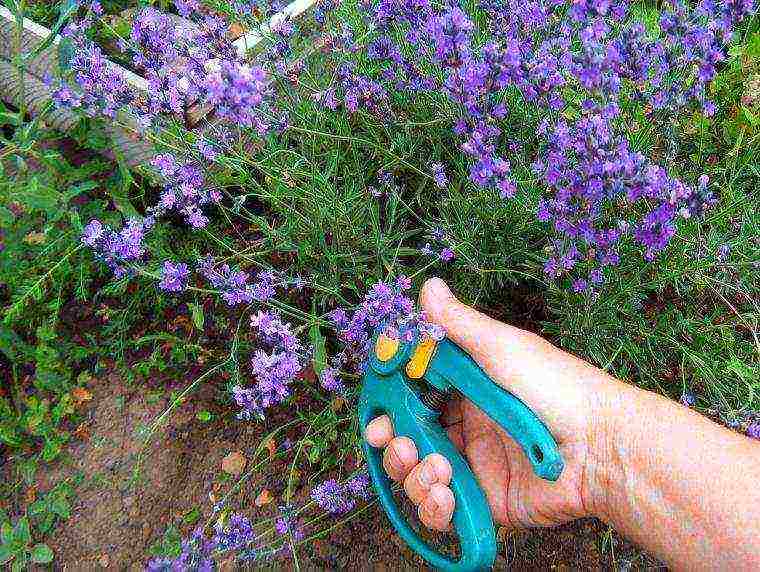
Purpose and technology of pruning lavender
Lavender shrubs need periodic pruning.If this procedure is neglected, over the years it will lose its decorative properties due to the exposure of the lower part of the stems. Pruning the plant in autumnremoving one third of the shoots. After flowering, this should not be done. In the spring, they get rid of the inflorescences of the last year.
Preparing flowers for winter
During the severe winter months, when the temperature drops to minus twenty-five degrees, flowers can freeze if there is not enough snow. To avoid this the bushes are covered using a light cover that does not retain water. Spruce branches are perfect for this purpose. Do not use dry leaves or sawdust as a shelter: these materials cause the bushes to dry out.
How to grow lavender in a country house in the Moscow region and the Leningrad region
In the Moscow region and the Leningrad region, English lavender is successfully cultivated - medicinal, or narrow-leaved. In these areas, the same principles of cultivation and subsequent care apply as in regions with a more benign climate. Seeds are sown in the ground after frosts - in May, and seedlings are placed in open ground, mainly in June. It is not recommended to sow planting material before winter. - it can freeze in a harsh winter.
How to cultivate lavender (video)
Lavender is a magical plant with rich flowers and divine scent. Not a single gardener will refuse the opportunity to decorate his site with a blooming fairy tale.
Attention, only TODAY!
Reviews and comments
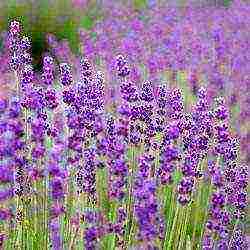 Lavender is a bright and fragrant plant that is grown not only by specialists in the field of landscape design, but also by ordinary gardeners. Fluffy shrubs will be a great decoration for alpine slides, flower beds or rockeries. This is a thermophilic plant, its planting and cultivation characteristics in different climatic zones are significantly different. Care for lavender should be regular. The main thing is to choose the right variety that is suitable for planting in the Moscow region or the Leningrad region. In the Urals, the features of reproduction and differences in cultivation are associated with the climatic conditions in this territory.
Lavender is a bright and fragrant plant that is grown not only by specialists in the field of landscape design, but also by ordinary gardeners. Fluffy shrubs will be a great decoration for alpine slides, flower beds or rockeries. This is a thermophilic plant, its planting and cultivation characteristics in different climatic zones are significantly different. Care for lavender should be regular. The main thing is to choose the right variety that is suitable for planting in the Moscow region or the Leningrad region. In the Urals, the features of reproduction and differences in cultivation are associated with the climatic conditions in this territory.
Types and popular varieties of lavender
Lavender can be grown outdoors or as an indoor pot plant. There are about 45 varieties. Shrubs are not only purple, you can also find white, pink, blue, as well as lilac and blue shades.
Attention! For each type of climatic conditions, a certain variety of lavender is suitable, so it is important to know the growing conditions for each of them.
There are four common types of this shrub:
- Narrow-leaved lavender. In gardening, it is also called spike-shaped, real or English. Its leaves are long, narrow, but dense. The inflorescences are spike-shaped, they are white, as well as lilac, purple and blue shades. Such lavender is winter-hardy, therefore it is suitable for growing in the middle lane. The following main varieties are distinguished: Hidcote, Rosea, Sentiva Blue, Munsted, Alba and others.
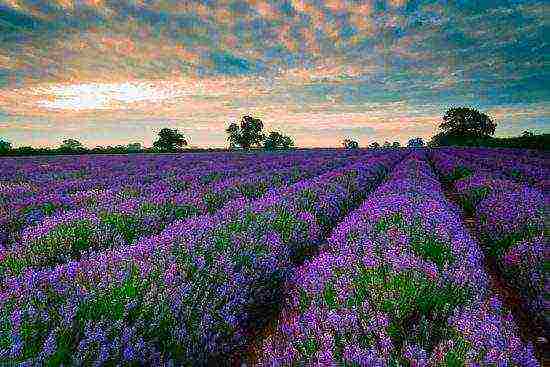
Lavender field
- Broad-leaved lavender. It is also known as French. This species is demanding on the climate and soil. Most often it is grown at home. The plant blooms in late spring. Inflorescences are burgundy, purple, lilac, pink and white. Has a strong, pronounced odor. Popular varieties: Helmsdale, Rocky Road, Willow Vale, Tiara and others.
- Lavender toothed. This species is thermophilic, the minimum temperature that it can withstand is up to -10 degrees. The plant blooms in July with large inflorescences of lilac, pink or dark purple shades. The most popular varieties are Regal Splendor, Pedundulata, Royal Crown.
- Hybrid lavender. It is sometimes called Dutch. It grows up to 2 meters in height, blooms in July. The leaves are silvery in color, the flowers are lilac, white and purple. Plants belonging to this species are completely frost resistant.Such varieties are widespread: Arabian Night, Richard Gray, Sawyers, Grosso and others.
How to grow lavender in the Moscow region
In Moscow and the Moscow region, mainly narrow-leaved lavender (English) is grown. In the season, shrubs adorn flower beds, alpine slides and flower beds. Also, the dried plant can be added to tea, used as an insect repellent, used for aromatherapy, etc. It is better to grow lavender in the Moscow region from seeds, as they are more resistant than seedlings.
The procedure should take place at a temperature of +5 degrees, the duration is 40 days. The seeds are pre-soaked, they can also be mixed with wet sand. After that, they are placed in the refrigerator.
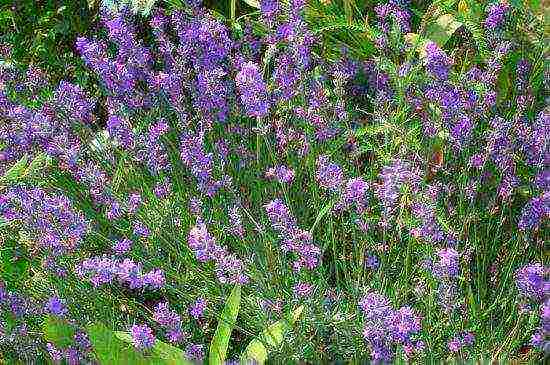
Narrow-leaved lavender
It is recommended to do the stratification in January. Late February (early March) is the time when seeds need to be sown in pots or containers. At this time, the temperature should be about 15 degrees and a well-lit place is chosen.
In the Moscow region, seedlings are planted in early June in the ground. The soil should be either alkaline or neutral with good drainage. The plant develops poorly on clayey terrain. Lavender will bloom only next year. If the plant has taken root normally, you can try to propagate it by cuttings.
Every fall, the plant must be pruned to the lignified part. Thus, lavender will be better preserved in the conditions of Moscow frosts. To cover the plant for the winter or not is a moot point. Some gardeners recommend falling asleep with leaves or peat before freezing, others believe that in such a climatic zone lavender can suffer from damping. It is allowed to cover shrubs with spruce branches.
How to grow lavender in the Leningrad region
Only narrow-leaved lavender has frost resistance, therefore this species is best suited for planting in open ground in the Leningrad region. You can plant other varieties, but it is better to do this not in flower beds, but in pots. Thus, gardeners can create any composition they come up with. But at the same time, the plant will not winter in the open field.
It is categorically impossible to sow narrow-leaved lavender before winter, as the planting material in this area may freeze. In most of the Leningrad Region, the soil for growing shrubs will have to be artificially improved. In the lowlands, there is an increased soil moisture, which is completely unsuitable for lavender. In such places, you can artificially dry the soil or plant shrubs on a hill. The soil practically throughout the entire region is poor in humus and is characterized by high acidity.
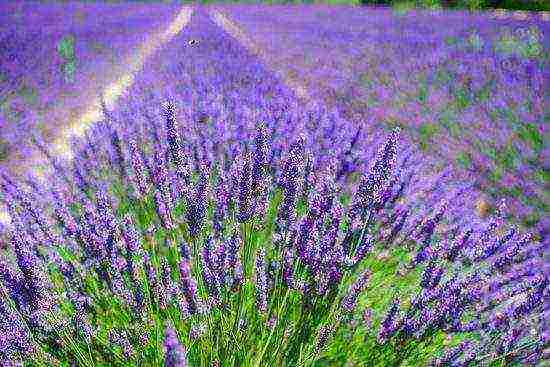
For colder regions, choose special lavender varieties
Features of growing lavender in the Urals
In the Urals, the harsh continental climate will be suitable only for narrow-leaved lavender. Natural conditions on the territory of this region differ significantly. Given the mild climate in the southern part of the Urals, it will be easier to grow lavender here. In the northern part, the plant will need a period to adapt. A prerequisite for growing in this part of the region is stratification.
In addition to narrow-leaved lavender in the Urals, it is possible to successfully grow thermophilic species of this plant, but either as a pot culture, or as an annual in a warm and favorable season. When self-sowing plants in this region, the seeds generally always die in the conditions of harsh winters. It is recommended to sow lavender outdoors only in May, and seedlings in June.
Attention! In the Urals, the most suitable way to propagate lavender is by seed.
Timely pruning is very important for the shrub. In the Urals, this is done in the spring in order to form neat bushes. Damaged and dry stems are removed from the plant. In summer, lavender is pruned after flowering. In the pre-winter time, the plant needs to be covered, you can also mulch with a thin layer of compost or peat.When growing lavender in the Urals (it does not matter on what soil), it is better to carry out additional feeding. In the spring, organic fertilizers are suitable, and in the summer, organic fertilizers or potassium-containing ones. It is not advisable to apply manure and nitrogen fertilizers, as this increases the growth of green mass.

Lavender needs annual pruning
In the Urals, in the Leningrad region and in the Moscow region, the cultivation of narrow-leaved lavender is practically no different. The only difference is in the soil, into which, if necessary, you need to apply certain fertilizers and plant care in the winter and pre-winter period. Any other type of lavender can be grown in pots.
Planting lavender: video
Lavender is the flower that many associate with French Provence. Therefore, most gardeners grow lavender in order to get at least a little bit in this stunning place. This flower has its own characteristics that must be taken into account when growing and nursing outdoors. And then lavender will look luxurious, smell great and delight you every day.
Lavender varieties
Lavender belongs to ornamental garden and park plants. It is an evergreen bush with small flowers that gather in single spikelets. Such a plant begins to bloom at the end of summer. His homeland is the Mediterranean. The shrub is unpretentious to the soil, frost-resistant, very fond of light and moisture. Flowers can be purple, white, blue and lilac. It doesn't matter where the gardener lives, in St. Petersburg or in the regions of Siberia, you can plant and care for lavender everywhere.
Today there are more than 30 varieties of lavender. They all differ in color, shape, height. The most popular types:
back to content ↑ Narrow-leaved lavender
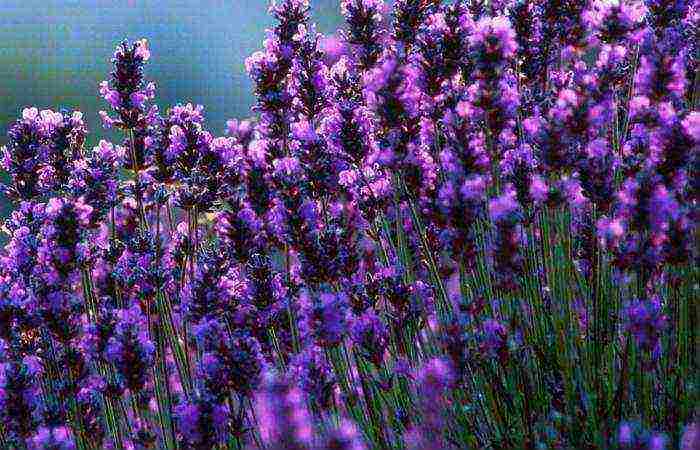
This species is also called in another way "English", "medicinal", "spikelet". It reaches 1 meter in height and width. The height of the peduncle is about 80 centimeters. Flowering teaches for June-July. It blooms with small flowers that are collected in a brush. This species includes different varieties: Alba (white), Beechwoodblue (blue), Rose (pink), Jim and Hydecoat (purple). It is very difficult to grow and care for such a lavender variety in the Moscow region, since the conditions are very far from those of the Crimean ones.
back to content ↑ Dutch lavender
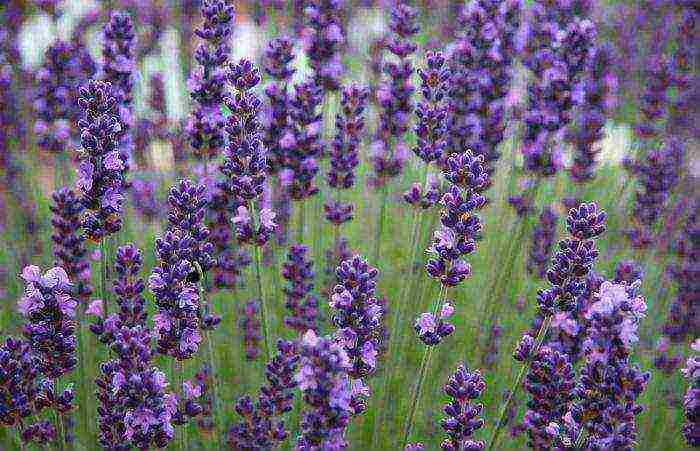
The bushes are up to 2 meters wide. The plant blooms for a limited amount of time - only in July. Famous varieties: Grosso, Saviers, Arabain Knight, Richard Gray.
back to contents ↑ Serrated lavender
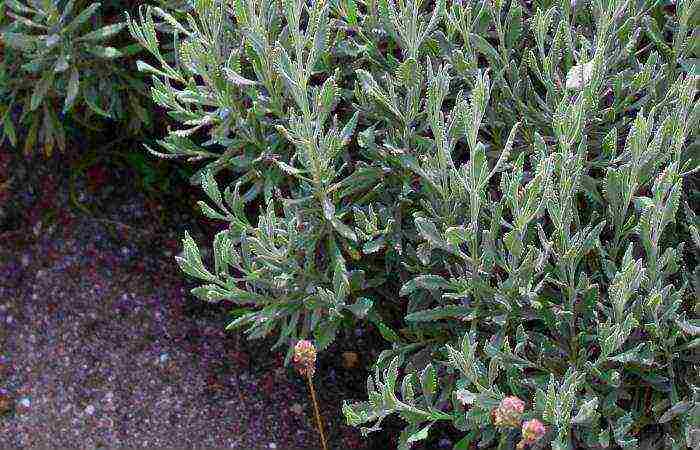
The leaves of this species are silvery, carved, and the flowers are large enough. The bush itself is very dense, reaching a height of only 30 centimeters. Usually this kind is grown at home, and such lavender becomes a houseplant.
back to content ↑ French lavender
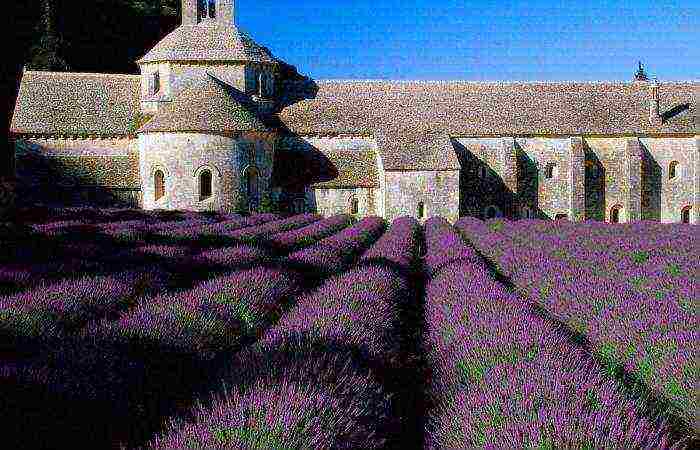
The bushes are voluminous, reaching a height of 1.3 meters. The leaves are large and the flowers are small. This type is very often chosen by designers to decorate hedges or borders along paths.
Many gardeners who live in the Leningrad region often plant and tend lavender. And any of the aforementioned species will grow well in this part of Russia.
back to content ↑ Planting with seeds
Despite the fact that lavender is considered an unpretentious plant, the process of planting by seeds is not the easiest one. This method can only be used if you do not have the opportunity to buy seedlings for planting lavender. Lavender seeds must be stratified. Under the influence of low temperature and moisture, the seeds swell and then germinate better. This procedure can also improve immunity and protect against sudden changes in temperature in winter.
After that, you need to plant the seeds in a container. After a week, the container should be covered with glass or plastic wrap and placed in a warm room. Do not forget to moisten the soil with a spray bottle. Sprouts will gradually appear.The room temperature should range from 15 to 22 degrees Celsius. In this room, lavender will grow stronger until spring.
When the weather improves, the frosts will pass, and the soil warms up, the plants can be transplanted into open ground to a permanent place. Just don't count on blooming in the same year. Lavender will need almost a season to develop its root system and build up leaf mass.
back to content ↑ Planting by cuttings
The simplest and easiest way of propagation is considered to be cuttings. The procedure itself is no different from grafting other crops. You need to do the following:
- Cut off an annual shoot with a sharp knife;
- Cut it into cuttings;
- Prepare a suitable soil for them;
- Make a depression and plant 2-3 centimeters in the ground;
- Cover the seedling with foil and create a greenhouse;
- Water the plant in moderation regularly.
The cuttings take root very quickly. Then it will only be necessary to plant the lavender in the chosen permanent place in the garden, but at the same time, the planting scheme must be observed.
to the content ↑ Reproduction by dividing the bush
Many gardeners have shrubs that have been growing for several years, so they may resort to propagation such as dividing the bush. To do this, you need to do the following:
- Choose a strong and healthy bush;
- Cut off the upper shoots in the summer;
- Till the ground near the shoots;
- In the fall, you need to dig up the lavender and carefully divide it into two parts. This should be done with minimal damage to the root system;
- Separated plants should be planted in open ground on the same day.
back to content ↑ Plant care
When caring for lavender, first of all pay attention to watering. This is especially important for young plants. While the seedling is getting used to its new location, it should be watered almost every two weeks.
On hot days, the bushes should be watered more often, that is, once a week. Do not overmoisten the shrub, because this is also dangerous for the plant.
As far as top dressing is concerned, this is a very important aspect in growing garden lavender outdoors. It is carried out in several stages:
- In spring, lavender should be fertilized with nitrogen. To do this, prepare a solution of 10 liters of water and 2 tablespoons of sodium humate. Each bush takes 5 liters of the resulting solution;
- The period of budding and flowering. At this point in the life of lavender, every 2-3 weeks, the bushes are fed with a complex fertilizer with the addition of potassium and phosphorus;
- It is imperative to prune immediately after flowering. In the fall, they do a rejuvenating procedure that prolongs the life of your plant. Young shrubs should be spud in autumn and spring.
back to contents ↑ Preparing for winter
Most hobbyists think that cutting lavender for the winter is not worth it, but they are wrong. This procedure must be done without fail. With each passing year, the stems of lavender become harder and thicker. And if you carry out timely pruning, this will help the lavender not only rejuvenate, but bloom more luxuriant and thicker. Lavender can be left unshorn, but then the stems will be vulnerable to frost and strong winds.
Pruning lavender for the winter is a snap. It is necessary to remove those branches that have already bloomed for two seasons. The stem of each plant consists of a woody part and a green one. For the winter, it is worth cutting off the green part in the place where the shoot is 3 centimeters higher than the stiff part. Thanks to this, lavender will be able to calmly survive the winter.
Lavender, like any other plant that grows outdoors, needs additional protection during the winter. Shrubs can survive frosts down to -25 degrees. In the southern regions, such measures will not be necessary, since there usually does not happen a strong drop in temperature. But many gardeners play it safe and cover the bushes with a thick layer of snow. Lavender in the Urals can also be planted, but do not forget to cover it for the winter.
If lavender grows in the middle lane, it must also be covered for the winter. Usually covered with a wooden or plywood box. You can also cover it with spruce branches. It is not recommended to insulate shrubs with fallen leaves or straw. Because of these two materials, the bushes begin to rot and rot.
